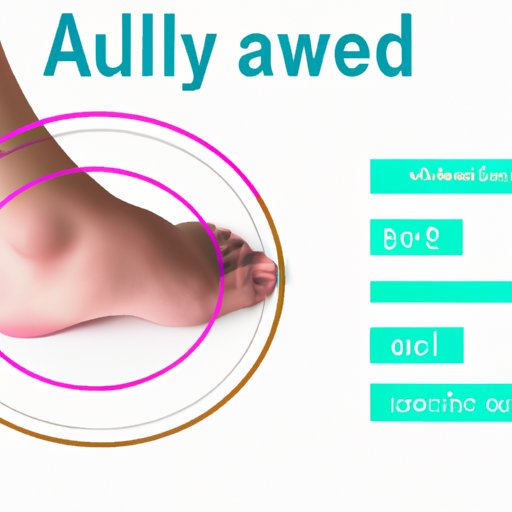
Introduction
Swollen feet and ankles are a common condition that can result from a variety of factors, including pregnancy, injury, or prolonged standing or sitting. It can be uncomfortable and even painful, but fortunately, there are several ways to alleviate the discomfort. In this article, we will explore natural remedies, exercises, dietary changes, and prescription therapies that can help reduce swelling and pain in the feet and ankles.
Natural Remedies
One of the easiest and most effective ways to reduce swelling in the feet and ankles is to soak them in cold water. This helps to constrict the blood vessels and reduce inflammation. Fill a basin with cold water and soak your feet for 10-15 minutes, two to three times a day.
Elevating the legs can also help to reduce swelling by promoting fluid drainage. Prop your feet up on a few pillows while lying down or use a footrest while sitting. Try to keep your feet elevated for at least 30 minutes a day.
Compression socks are another popular natural remedy for swollen feet and ankles. They work by applying pressure to the legs, promoting blood flow and reducing inflammation. Wear them during the day, taking them off at night to let your feet breathe.
Finally, massaging your feet and ankles can help to reduce swelling and promote blood and lymphatic flow. Use your hands or a tennis ball to apply gentle pressure to the areas around your feet and ankles, making circular motions with your fingers or rolling the ball back and forth.
Exercise
Regular exercise is vital for promoting blood flow and reducing inflammation in the body. For people with swollen feet and ankles, low-impact exercises are the best option. Walking, swimming, and cycling are all great choices.
Aside from these, there are also specific exercises that can help reduce swelling in the feet and ankles. Ankle circles, for example, involves rotating your feet in a circular motion, while leg raises involve lifting your legs one at a time while lying down or sitting in a chair. Repeat each exercise for 10-15 reps, two to three times a day.
Dietary Changes
What you eat can also have an impact on the swelling in your feet and ankles. Try to reduce your salt intake as salt can cause fluid retention in the body. Instead, focus on eating anti-inflammatory foods like leafy greens, berries, and fatty fish. Drinking plenty of water can also help to flush out toxins and reduce inflammation.
Prescription Medications and Therapies
If swelling and pain persist, there are also several prescription medications and therapies that may help. Diuretics are a type of medication that can help to remove excess fluid from the body, thereby reducing swelling. Steroid injections can also be used to reduce inflammation and pain in the affected area. Finally, physical therapy can help to alleviate swelling and prevent future flare-ups by improving circulation and strengthening the affected muscles.
Prevention Techniques
There are several prevention techniques that can help to reduce the likelihood of swollen feet and ankles. Wearing comfortable shoes that fit properly and avoiding high heels can help prevent injury and strain. Taking breaks from sitting or standing for long periods can also reduce the likelihood of swelling. Losing weight and getting regular exercise can also improve circulation and reduce inflammation in the body.
Conclusion
Swollen feet and ankles can be uncomfortable, but there are several ways to alleviate the discomfort. Natural remedies like cold water soaks, elevating the legs, and compression socks can help, as can regular exercise and dietary changes. In some cases, prescription medications and therapies like diuretics, steroid injections, and physical therapy may be necessary. However, it is essential to consult a doctor if swelling and pain persist to rule out any underlying medical conditions.





